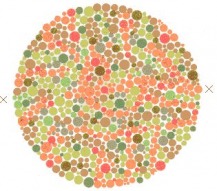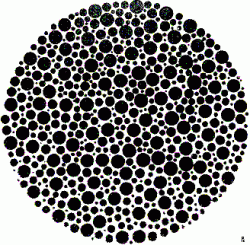Daltonism

Color blindness, a color vision deficiency, is the inability to perceive differences between some of the colors that others can distinguish.
Color blindness affects a significant number of people, although exact proportions vary among groups. In Australia, for example, it occurs in about 8 percent of males and only about 0.4 percent of females.
In the United States, about 7 percent of the male population – or about 10.5 million men – and 0.4 percent of the female population either cannot distinguish red from green, or see red and green differently (Howard Hughes Medical Institute, 2006). Click HERE FOR A FREE TEST.
By clinical Appearance

Based on clinical appearance, color blindness may be described as total or partial. Total color blindness is much less common than partial color blindness. There are two major types of color blindness: those who have difficulty distinguishing between red and green (Dichromacy, protanopia and deuteranopia), and those who have difficulty distinguishing between blue and yellow (Dichromacy, tritanopia). Click HERE FOR A FREE TEST.

